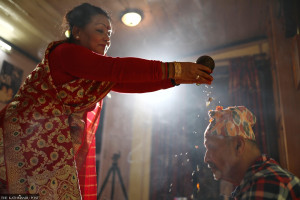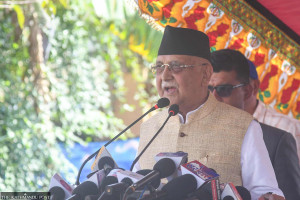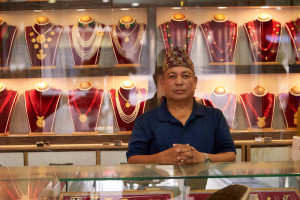Culture & Lifestyle
Pursuing her passion, stitch at a time
After years of self-doubt, embroidery artist and jewellery maker Navina Karki is turning passion into a creative career.
Sanskriti Pokharel
Navina Karki, an embroidery artist and jewellery maker, thought she was anything but creative growing up. “Even drawing a simple flower took me hours,” she recalls, convinced that art wasn’t her thing.
After selling her artwork in India, Australia, Canada, and the US, Karki feels that creating is truly her calling. A day without art leaves her questioning her purpose. She says, “I always feel the urge to create something. If I’m not, I wonder what else I’m here for.”
Her failed attempts to create art during childhood made her believe that artistry is an inborn trait. Those who get involved in it late cannot succeed. Unbeknownst to her, she would eventually be the one to disprove this belief of hers.
After +2, Karki moved to Bhaktapur for higher studies. At that time, she wanted to ‘explore’ and discovered Vincent Van Gogh’s paintings online.
One day, YouTube suggested an embroidery video, and she clicked on it out of curiosity. Until that moment, she hadn’t even managed to thread a needle, but inspired by the video, she decided to give it a go. In 2021, Karki purchased some supplies and embarked on her embroidery journey. Her first work was a sunflower, which took fifteen minutes to complete.
“I took a photo, posted it on my Instagram story, and received compliments. This encouraged me to keep going. I felt a real sense of achievement from learning something new, so I went on to embroider more flowers.”
Unfortunately, Karki came down with a high fever, forcing her to rest and putting her embroidery journey on pause. As she drifted in and out of sleep, she dreamed of embroidering and often wondered when she would feel well enough to resume.
During this tough time, Karki experimented with line art on tote bags, which fulfilled her. However, another family emergency arose, requiring her to return home. There, her parents encouraged her to focus on studying for the civil service exams. They hoped she would prioritise her studies and pursue a secure job. They found it hard to believe in her embroidery ambitions, knowing she hadn’t even mastered threading a needle.
Karki prepared for the civil service exams at her family's urging, but the outcome was disappointing—she didn’t pass. “I was torn,” she says, “between preparing for the exams again or continuing my paused embroidery journey.”

Karki chose the latter. She had brought her supplies home and decided to try stitching an eye surrounded by small flowers. Yet, this attempt also fell short of her vision, as the result wasn’t what she had imagined.
After battling with disappointment for days, Karki tried again. She had previously focused on simpler line art and floral designs, but this time, she challenged herself with an ambitious project: embroidering Van Gogh’s ‘Starry Night’ inside a heart outline. Though initially pleased with the result, her satisfaction waned as she looked at it. However, her friends urged her to share it on Instagram.
Karki posted the piece without hesitation, and her notifications soon buzzed with likes and shares. To her surprise, a follower messaged her, asking if the artwork was for sale. Unsure of what to charge, she sought advice from a close friend and set a price. But when she shared the price, the admirer insisted on paying more, recognising the time and creativity she had invested in the piece.
As Karki’s artwork began to sell, her parents’ outlook shifted, and they grew supportive of her work. Unlike in the early days of her embroidery journey, they no longer worried but supported her by ensuring she had quiet time to work.
With her newfound encouragement, Karki received more orders. She purchased additional threads and tote bags using the earnings from her first sale. One of her Instagram followers from Canada requested Van Gogh’s ‘The Starry Night’ within a heart outline, but this time embroidered on a tote bag. Though Karki hadn’t tried embroidering on tote bags before, she agreed to take on the challenge. Unlike regular fabric, which is soft and easy to stitch, tote bags have a rough, sturdy texture that makes embroidery difficult and can even cause needles to break.
Despite her doubts, Karki refused to let the fear of failure hold her back. Determined to finish the piece within seven days, she stitched her vision onto the tote bag. However, the process wasn’t easy; the bag kept folding awkwardly, and Karki wondered if the customer would even want it. Seven days turned out to be too ambitious—it ultimately took her a month to complete the piece.
The Canadian customer purchased the tote bag and even paid Karki more than her original price. “This experience taught me that persistent hard work pays off no matter how challenging a task is.” Motivated by this success, Karki used her earnings to buy more tote bags and sold many of her embroidered pieces.
She chose to embroider ‘The Starry Night’ and other works by Van Gogh because his style translates well into embroidery. As a post-impressionist painter, Van Gogh used patterned brushstrokes and distorted shapes, which lacked the intricate details of realism. This made his art easier to adapt to threadwork. “Without losing the essence of his paintings, I could capture his works quite well in embroidery,” she says.
Another aspect Karki appreciates about embroidery is that mistakes aren’t final—the thread can simply be undone. This flexibility makes her less fearful of making errors.

Some pieces take Karki over a month to complete, mainly due to the creative process. She spends most of her time planning, considering what design to create, which thread colours to use, and the symbolism she wants to convey. She waits until she has a clear mental image before beginning to stitch, as she believes this thoughtful preparation is essential to her work.
Originally from the Tarai, Karki has always loved gazing at open landscapes, so she feels connected to landscape embroiderers. “I rarely embroider mountains,” she says, “because I haven’t seen enough of them and don’t feel any attachment. Creating things that resonate with me just feels easier.”
However, her sister, who lives in Dubai, once requested a mountain embroidery piece to purchase. Karki admits she might never have considered embroidering mountains without her sister's request.
In addition to creating embroidered landscapes and floral designs on tote bags, she also crafts pendants and earrings, which she sells. She sources raw materials from the local market and uses pliers to skillfully wire-wrap components for her earrings. For pendants, she embroiders intricate designs onto fabric, then cuts and places them into frames or bezels typically used in resin art to complete the pieces.
Though Karki never intended to make a living from her art, she now takes great joy in supporting herself through it. She reflects, “While I earn from teaching, the joy of being appreciated for my art is far more profound.”
Some of Karki's embroidery pieces sometimes feel too personal to share or sell. She admits that she pours so much of herself into them that they become too close to her heart to part with. This emotional attachment often prevents her from selling them, even though she might otherwise.
Having moved several times—first from Udayapur’s villages to the Bazaar, then from Biratnagar to Bhaktapur—Karki always carried her most cherished belongings. Inspired by this, she creates wearable, portable art so others can take their favourite pieces wherever they go.
In Nepal, sustaining a livelihood as an artist takes work. Karki reflects, “Most of the time, we do not get paid what we deserve, and that stings. On the other hand, seeing artists like Anna Kumari Dahal thrive in this field is inspiring and keeps me from giving up on my artistic passion.”
For Karki, art is a form of meditation that calms her mind, body, and heart. It silences her overthinking and helps keep loneliness at a distance. Looking ahead, she envisions herself dedicating all her time to embroidery. “Right now, I’m busy with my studies and a teaching job, so I can’t fully focus on embroidery. But I want to devote all my time to it in the future.”




 17.12°C Kathmandu
17.12°C Kathmandu















